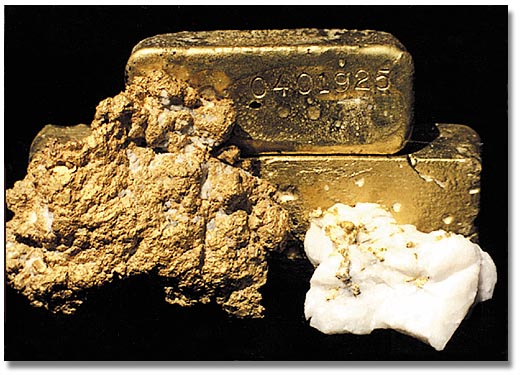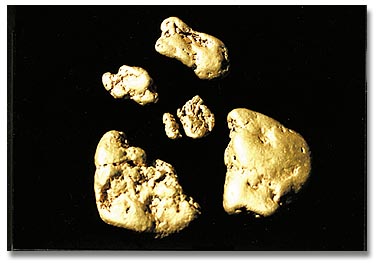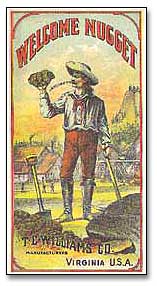By Al Schulz
GOLD IN MORE MODERN HISTORY:

Prior to American discoveries, Europe enjoyed the distinction of being the world’s largest producer and hoarder of gold. First it came from the areas of the Mediterranean and then from Africa. The 16th century brought Spanish explorers to search for gold in Central and South America. The looting of Aztec and Inca temples from Mexico to Peru followed, and more gold than the world had ever seen flowed back to Spain. South America had supplied most of the world’s gold until the early 1800’s.
In 1513 the Caribbean island of Cuba became a Spanish stronghold in the Americas when gold was discovered. Mining continued for 20 years before supplies dwindled, sending gold seekers to other islands and eventually South America. Estimates range between 600-800 thousand ounces of gold recovered before fortune seekers moved on.
America’s movement towards independence in the 1770’s brought England’s European rivals into the picture. Since we suffered from a shortage of gold, France, and Spain to a lesser degree, loaned the Colonies over $20 million in gold and silver. This eventually saved the independence movement, since our Continental dollars were not backed by gold. Our own first major gold discovery would not come until almost three decades later (1799) in North Carolina.
picture. Since we suffered from a shortage of gold, France, and Spain to a lesser degree, loaned the Colonies over $20 million in gold and silver. This eventually saved the independence movement, since our Continental dollars were not backed by gold. Our own first major gold discovery would not come until almost three decades later (1799) in North Carolina.
Georgia gold was first discovered on Cherokee Indian territory in 1828, an area which later became known as Dahlonega (Indian name for “yellow money”). The federal government established a mint in the area in 1838 which produced gold coinage in excess of $6,000,000 until 1861. That year, with the advent of the Civil War, the mint at Dahlonega closed down its operations as Georgia withdrew from the Union.
Even presidents find gold! Thomas Jefferson, third chief executive of these United States (1801-1809), reported finding a four pound rock-bound specimen that contained an ounce of gold. This was in his native Virginia, one of the first gold producing colonies.
The California gold rush of 1849 was quickly followed by rushes to Australia in 1851, South Africa in 1886 and Alaska and Canada in the 1890’s. In less than half a century the world’s supply of gold had more than doubled.
The first year of the California gold rush was not without its problems. Diseases ran rampant in many mining camps. Lack of sanitary facilities brought outbreaks of cholera and dysentery in the more crowded gold fields.
A lack of fresh fruits and vegetables caused an ailment called scurvy in which there is a lack of vitamin C. The results were bleeding gums, loose and lost teeth, exhaustion and diarrhea.
When physicians were called in to treat miners they often succumbed to “gold fever” and wound up ignoring their own health.
Crime, surprisingly, was minimal. Theft was made virtually obsolete in the face of so much wealth just lying around in local rivers and streams. That changed, however, once the “pickings” got leaner and claims were disputed.
 By the end of the first year of the 1849 California gold rush it is estimated that close to 100,000 individuals seeking their fortunes had made it to area diggings. They came from foreign lands as well. In fact 25% of all 49’ers were not Americans. They hailed from as far away as China, Australia, England and France.
By the end of the first year of the 1849 California gold rush it is estimated that close to 100,000 individuals seeking their fortunes had made it to area diggings. They came from foreign lands as well. In fact 25% of all 49’ers were not Americans. They hailed from as far away as China, Australia, England and France.
1850 marked the year that the Foreign Miners Tax was evoked. Talk about discrimination–this tax of $20 a month was primarily aimed at Chinese and Mexican workers, but affected all foreign gold seekers as well.
Due mostly to the protests of Irish, English and German miners, the fee was lowered to $4 monthly in early 1853.
Many of the people who came from other lands during the gold rush to California did not necessarily come of their own free will! Australia emptied many of her overcrowded prisons and shipped criminals to America’s gold fields. Louis Napoleon, president of France, held a lottery in 1850 that would send the poor to California to seek their fortunes. This too was just a way of unloading undesirables, political enemies, prostitutes, etc., while lining his own pockets with the lottery proceeds.
Sam Brannan will go down in the annals of history as an extraordinarily astute businessman. During the first year of the California gold rush, instead of heading to the newly discovered gold sites, he stayed behind to open several general stores. These were located in and around the area of Sutter’s mill and fort. They were stocked with all the provisions needed by miners in the field such as picks, shovels, pans, and food.
It is said that Brannan bought up every available pan to be had in San Francisco at 20 cents each and later sold them for anywhere from $10 to $15 each. The store
at the fort is estimated to have grossed nearly $40,000 during the first four months. Most of his accepted payment was in gold and he amassed a fortune without ever putting a pan in water.
Just ten short years after the discovery of gold at Sutter’s Mill, California had extracted more than half a billion dollars worth of gold. This was 35 times the amount the United States paid Mexico for the California Territories.
At the start of the California gold rush there was no fixed price for the yellow metal. It was a supply and demand situation, with a fluctuating value between a low of $6 per ounce to a high of $18 per ounce. The price finally stabilized in 1854 at $16 per ounce with the opening of a branch of the United States Mint in San Francisco.
Much has been written about all the silver that had been mined at Virginia City’s Comstock Lode, but it was gold that started that rush. In twenty years of mining, the major ore was silver (57%), but gold was second by only a small margin (43%).
Placer deposits provided the earliest recoverable gold (nuggets in streams and rivers). Then men had to tunnel into the earth to extract lode deposits. Today it is deep (2,000 ft.) drillings in sedimentary limestone rock and epithermal deposits in ancient reefs that provide the gold. The earlier discoveries of sculptured and well defined nuggets are becoming harder to find with each passing decade, especially in higher weight categories. A one-ounce, high character nugget today is harder to find than a comparable five-carat diamond.
Alaska first heard the cry of “gold” in 1896. The region was the Klondike in Canada’s Yukon Territory. It immediately shifted thousands of workers from productive salmon fishing and fur trapping and lured them to the gold fields. The bureau of Geological and Geophysical Survey estimates that Alaskan miners and prospectors are recovering around 150,000 ounces of placer gold annually.
Goldfield, Nevada — the ghost town that wouldn’t die! Being rebuilt and recreated as a major tourist attraction, it had been in a state of arrested decay until recently. This meant that no further erosion of existing facilities would take place. Now, however, renovations and reconstruction are progressing at a record pace.
Most recently, the attraction that has brought more visitors as well as gold seekers to the area is the report of a single discovery of a 1 1/4 ounce nugget in the area of the Goldfield Hotel on Columbia Street. In the early 1900’s, $90,000,000 in mineral wealth was unearthed in Goldfield, which is situated on Hwy. 95 between Reno and Las Vegas.
Is a large single gold nugget find still possible? Judge for yourself! Jack Bray of Feysville, Australia unearthed a 267-ounce nugget dubbed the “Golden Aussie” in August of 1980. He sold his “monster” for $250,000. In 1983 at a large placer mining operation in Sierra Pelada, Brazil, a prospector unearthed a 137-pound nugget that fetched one million dollars on the open market. Latest U.S. finds: Carl Brunner, a 35-ounce “rock” found in the Wrangell mountains of Alaska. It assayed out at 75% gold in 1989. Also in 1989 at a mining operation in Montana a 27-ounce nugget, .900 fine in purity, was discovered by Arthur Fulmer… Yes, they are still out there! And let’s not forget the recent huge nugget find in California. A gigantic 60-pound chunk of gold was discovered near Jamestown by workers at the Sonora Mining Corp. The 60 pounder was nearly three feet in length and six inches thick. This big nugget has touched off a new rush to the area, just 200 miles from Sutter’s Mill, the site of the strike that started the 1849 California gold rush.
Australia has had some giant nugget finds. There is, of course, the largest nugget ever found in that country, the “Welcome Stranger.” Discovered in 1869, it weighed an incredible 2,284 ounces. The “Golden Eagle,” unearthed in 1931, weighed in at 1,235 ounces. More recently was the “Golden Aussie” mentioned above.
country, the “Welcome Stranger.” Discovered in 1869, it weighed an incredible 2,284 ounces. The “Golden Eagle,” unearthed in 1931, weighed in at 1,235 ounces. More recently was the “Golden Aussie” mentioned above.
Australia was the first to apply names to its larger nugget finds. Most notably the Welcome Stranger, Hand of Faith, Little Hero and Poseidon come to mind. Several of these nuggets appeared, until recently, on Australia’s gold coins.
If you want to see one of these spectacular nuggets up close, the 62 pound “Hand of Faith” nugget resides in the lobby of the Golden Nugget Casino in Las Vegas, purchased several years ago for one million dollars.
- Here is where you can buy a sample of natural gold.
- Books & Videos about gold prospecting
- More about the history of gold
- More about how to prospect for gold
- Schedule of Events





